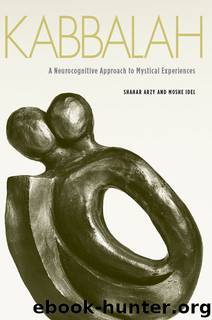Kabbalah: A Neurocognitive Approach to Mystical Experiences by Shahar Arzy & Moshe Idel

Author:Shahar Arzy & Moshe Idel
Language: eng
Format: mobi
ISBN: 9780300152371
Publisher: Yale University Press
Published: 2015-06-30T06:00:00+00:00
2. Ecstatic Kabbalah as a Seminal Investigation of the Human Self
The phenomenologies of the Kabbalistic material analyzed in this book and their comparison to modern cognitive experiments in healthy people and to observations in neurological patients suggest that major trends in Jewish Kabbalah managed to alter distinct neurocognitive mechanisms through the use of specific techniques. These excitations caused a change in the mystic’s processing of functions related to his own self, such as the sense of embodiment or visuo-spatial perspective taking, leading to different variants of autoscopic and trance experiences and accompanied by prominent prophetic-like experiences of a “speaking double” or internal “maggidic” voice, thus facilitating further expansion of the borders of the mind and consciousness. We therefore propose that it is the mystical technique that leads the mystic to experience autoscopy, heautoscopy, out-of-body experience, or trance. The mystic might interpret these as sacred or prophetic experiences that reveal mystical secrets about human or divine nature.
Since the introduction of neuroimaging, dozens of studies have investigated the so-called neural mechanism underlying mystical techniques, especially meditation, which best fits the neuroimaging theater. However, such a “brain-mapping” approach is limited and different from ours. Here, we did not scan practitioners from certain traditions using functional MRI or electrical neuroimaging during their mystical exercises or attempts. Rather, we tried to stress the importance of the assemblage of technical, sociocultural, and linguistic factors for the construction of the human self, as based on physiological and neurocognitive characteristics that were altered by the use of ecstatic mystical techniques.
Adapting phenomenological, neurological, and neurocognitive approaches, we have suggested how major trends in Jewish mysticism helped mystics to achieve their mystical experiences by using practical techniques that affected their “intrinsic” self-processing and sense of embodiment. These techniques activate brain mechanisms at the temporo-parietal/precuneal, medial-temporal, or medial prefrontal/orbito-frontal cortices, which together form the “intrinsic” system governing the processing of body and self.4 Such an approach presents a valuable benefit to consciousness studies and to the neuropsychological understanding of the “self” since it separates the “self” from the body on different levels. We may now extend the proposal presented in the introduction of this book which stated that contemporary folk-psychology about the mind might have emerged from the older notion of the “soul” or “proto-concept of mind,” and we hope that the reader is now convinced that the ecstatic Kabbalah mystics indeed used ex-static autoscopic and dissociative phenomena as early and pioneering experimental models in the investigation of the philosophy of mind and the cognition of the human “self.” While our technology has advanced much since the time of ecstatic Kabbalah, our ability for introspection has not. Just as our cultural and scientific lives may be influenced by masterpieces in literature or art, similar inspiration may also derive from the philosophical, psychological, and cognitive work of early scholars, such as the Jewish mystics described in this book. Their call for the reader to look at the self from a nonhabitual perspective, and from this perspective to further introspect, still holds as much as it did centuries ago, and maybe even more.
Download
This site does not store any files on its server. We only index and link to content provided by other sites. Please contact the content providers to delete copyright contents if any and email us, we'll remove relevant links or contents immediately.
The Secret Power of Speaking God's Word by Joyce Meyer(2867)
Man's Search for Meaning by Viktor E. Frankl(2574)
Mckeown, Greg - Essentialism: The Disciplined Pursuit of Less by Mckeown Greg(2356)
MOSES THE EGYPTIAN by Jan Assmann(2347)
Devil, The by Almond Philip C(2244)
Unbound by Arlene Stein(2205)
The Complete Dead Sea Scrolls in English (7th Edition) (Penguin Classics) by Geza Vermes(2203)
I Capture the Castle by Dodie Smith(1936)
Schindler's Ark by Thomas Keneally(1779)
The Invisible Wall by Harry Bernstein(1727)
The Gnostic Gospel of St. Thomas by Tau Malachi(1712)
The Bible Doesn't Say That by Dr. Joel M. Hoffman(1620)
The Secret Doctrine of the Kabbalah by Leonora Leet(1553)
Political Theology by Carl Schmitt(1516)
The Jewish State by Theodor Herzl(1484)
A History of the Jews by Max I. Dimont(1465)
The Dead Sea Scrolls Bible by Martin G. Abegg(1441)
The Book of Separation by Tova Mirvis(1438)
Oy!: The Ultimate Book of Jewish Jokes by David Minkoff(1311)
